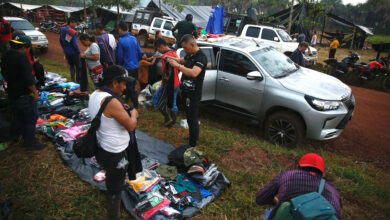Eerie silence at Korean border belies heightened tensions

By Andrés Sánchez Braun
Panmunjom, South Korea, Oct 4 (EFE).- The growing tension on the Korean peninsula is a stark contrast to the ghostly atmosphere at the Joint Security Area (JSA), the only portion of the Korean Demilitarized Zone where North and South Korean troops used to stand face-to-face.
Oblivious to the border that has divided Koreans on the ground for seven decades, flocks of Baikal ducks have already begun to fly over the DMZ in search of warmer wetlands further south.
Access to the area was closed after the outbreak of the pandemic but it recently reopened for tourists and journalists.
Just a few hours before a media tour arrived on Tuesday at Camp Bonifas, the last United States military base before the border, Pyongyang launched a ballistic missile that flew over Japan for the first time in five years.
The missile flew some 4,500 kilometers, the longest distance ever covered by a North Korean missile.
Further along the DMZ — a 250-kilometer-long, four-kilometer-wide area that divides the Korean peninsula in two — the media tour reaches the JSA, which for many symbolizes the conflict between North Korea and the South Korean-US bloc.
The tense eye contact that used to take place between the troops across the Conference Row “blue buildings” — the site for dialogue between North and South Korea and where North Korean leader Kim Jong-un met with former US president Donald Trump in 2019 — has vanished.
The extreme paranoia with which the North Korean regime is dealing with the Covid-19 pandemic has led to the retreat of its soldiers deployed in the JSA.
“Now they don’t even leave Panmungak,” says US Lieutenant Colonel Griff Hofman, who is leading the media tour, referring to the main North Korean building on the north side of the Conference Row.
The concrete plinth that symbolizes the Military Demarcation Line and divides the JSA in two is overgrown with weeds, a reflection of the current state of relations between Seoul, Washington and Pyongyang, which has rejected all proposals for dialogue.
The steps leading up to Panmungak are in a similar state of abandonment since no North Korean military personnel has set foot in the area since the beginning of 2020.
Suddenly, a curtain opens at a window on the first floor of Panmungak. A North Korean soldier in an orange PPE suit peeks out briefly before disappearing again.
“They wear them even though they stay inside the building at all times,” Lieutenant Colonel Griff Hofman says.
Despite the silence hanging over the JSA, the tension between the two sides is tangible. One of the cooling towers of the Freedom house on the south side still has four bullet holes.
Nearby, the symbolic pine tree planted by Kim Jong-un and Moon Jae-in during their first summit in 2018 gives a little more hope.
On the opposite flank, from a lookout on the southern side, the North Korean village of Kijong can be seen, with a giant national flag said to be the fourth largest flagpole in the world.
Just behind, a mountain range hides thousands of artillery pieces aimed directly at South Korean and US military positions which many believe are capable of hitting points north of Seoul, located just 70 kilometers to the southeast. EFE
asb/mp/ks





